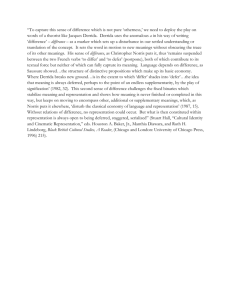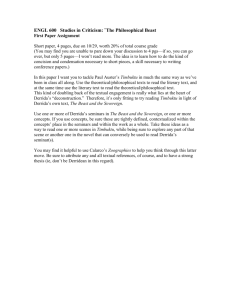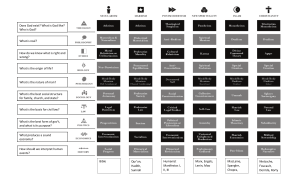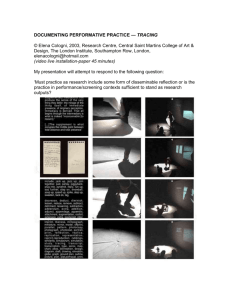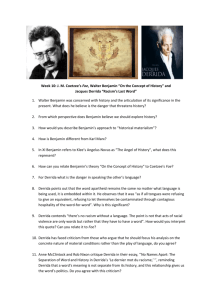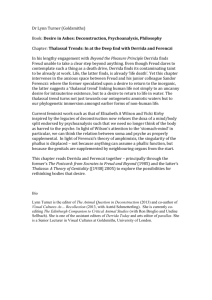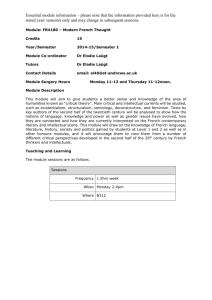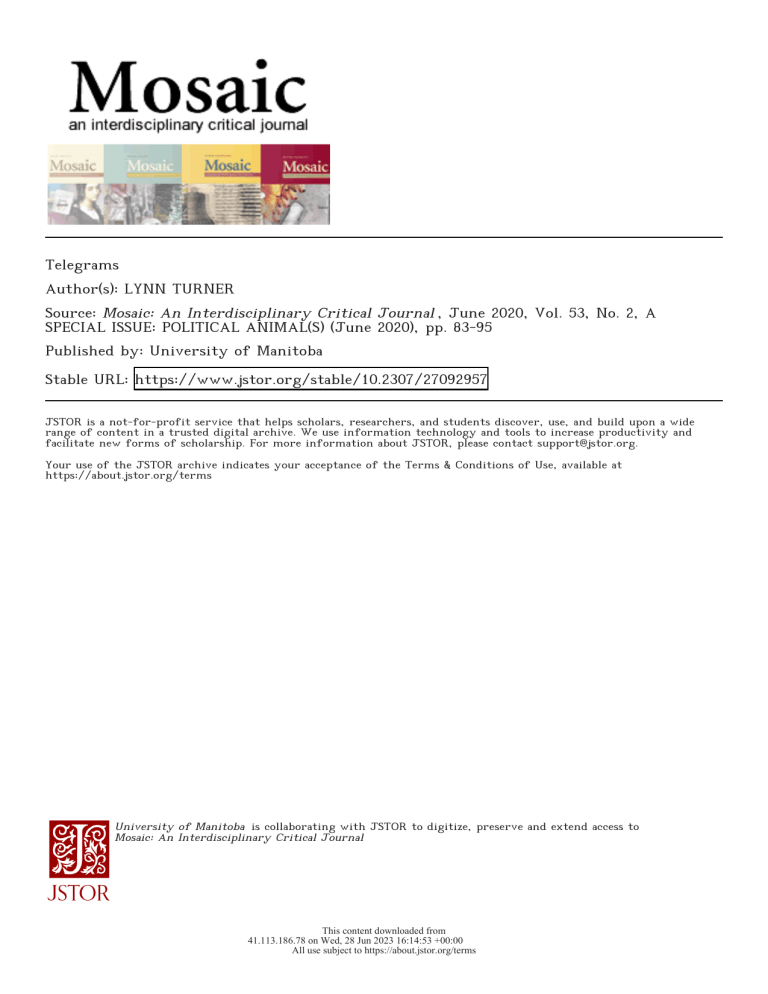
Telegrams Author(s): LYNN TURNER Source: Mosaic: An Interdisciplinary Critical Journal , June 2020, Vol. 53, No. 2, A SPECIAL ISSUE: POLITICAL ANIMAL(S) (June 2020), pp. 83-95 Published by: University of Manitoba Stable URL: https://www.jstor.org/stable/10.2307/27092957 JSTOR is a not-for-profit service that helps scholars, researchers, and students discover, use, and build upon a wide range of content in a trusted digital archive. We use information technology and tools to increase productivity and facilitate new forms of scholarship. For more information about JSTOR, please contact support@jstor.org. Your use of the JSTOR archive indicates your acceptance of the Terms & Conditions of Use, available at https://about.jstor.org/terms University of Manitoba is collaborating with JSTOR to digitize, preserve and extend access to Mosaic: An Interdisciplinary Critical Journal This content downloaded from 41.113.186.78 on Wed, 28 Jun 2023 16:14:53 +00:00 All use subject to https://about.jstor.org/terms “Telegrams” attends to the persistent problems that lie in the theoretical severance of voice from speech. While scholars such as Dolar attempt to anchor psychoanalysis as the field best placed to account for this distinction, “Telegrams” invites you to return to Derrida, to Cixous, and to the more-than-human poetics of deconstruction. Telegrams LYNN TURNER One cannot hear sounded this remains of ram the shofar without feeling the shock of a fracture, in one’s chest, of time. It is voice from the there, the voice that leaps out of the chasm, the opening of the lips of this world to that world after the end of the world. —Hélène Cixous, Insister (148)1 his essay attends to the problematic alignment of trauma, the voice, and the political, problematic in its influential role in the articulation of the human as against what we call the animal. This alignment, broadly inherited from Aristotle, is given new life in particular contemporary psychoanalytic discourse. Together with the distance named by the “tele-,” and the animality inferred by the “rams,” “Telegrams” begins an intervention into this complex violent legacy through the work of Jacques Derrida. Where post-Lacanian psychoanalysis structures the Real in terms of trauma from which the subject of the signifier and thus the political world is constitutively barred, Derrida mourns the end of the world after the death of every other. “Telegrams” thus sounds the distinction between the psychoanalytic administration of the law and deconstructive hyperbolic ethics as the expression of fidelity to the plural in the “political animals” of this issue. T Mosaic 53/2 0027-1276-07/0830140$02.00©Mosaic This content downloaded from 41.113.186.78 on Wed, 28 Jun 2023 16:14:53 +00:00 All use subject to https://about.jstor.org/terms 84 Mosaic 53/2 (June 2020) Transmute Why don’t we turn our ears toward a call which addresses and provokes above all else […] To turn one’s ears to the other when it speaks to “whom,” to “what,” to this “who” which has not yet been assigned an identity […]. – Derrida, “Voice II” 163 ristotle famously names man in his Politics “as a political animal in a greater measure than any bee or any gregarious animal” by virtue of his sole possession of speech. In the History of Animals he goes into some physiological detail about why he finds this to be the case (1.1253a): A The fact is that no animal can give utterance to voice except by the action of the pharynx, and consequently such animals as are devoid of lung have no voice; and language is the articulation of vocal sounds by the instrumentality of the tongue. Thus, the voice and larynx can emit vocal or vowel sounds; non-vocal or consonantal sounds are made by the tongue and the lips; and out of these vocal and non-vocal sounds language is composed. Consequently, animals that have no tongue at all or that have a tongue not freely detached, have neither voice nor language; although […] they may be enabled to make noises or sounds by other organs than the tongue. (Aristotle qtd. in Zanatta 6, emph. mine) Other animals may make noises, then, but they are physiologically barred from rendering them articulate. Aristotle’s limited knowledge of non-human physiologies notwithstanding, his hierarchy between articulate speech as the only sound that matters and inarticulate voices and other noises is clearly one that requires deconstruction. It is the division that supports exclusive human claim upon the moral and the political. Even where some animals might be equipped to vocalize, the “instrumentality” of the tongue is keyed to meaning.2 While Derrida’s insistence on dismantling the one true line between the human versus the animal and his concomitant aspiration to address each animal in their singular “this-ness”—“Ecce-animot”—both matters and welcomes physiological rejoinders, it is not the sole direction to which this chapter will speak (Animal 48). Rather, it is the particular way that voice as well as speech now accrues to the human subject that must be deconstructed. This accrual has gained traction in the post-Lacanian psychoanalysis of Mladen Dolar, specifically with regard to his 2006 book, A Voice and Nothing More, a book that has been widely lauded by Lacanian and Deleuzian scholars alike. Voice, for Dolar, conceptualized after Jacques This content downloaded from 41.113.186.78 on Wed, 28 Jun 2023 16:14:53 +00:00 All use subject to https://about.jstor.org/terms Lynn Turner 85 Lacan as the silent “voice-object,” invalidates any engagement with the sounds of voices whether made by humans or other animals (and thus blocks any possibility of taking sounds made by animals as worthy of note). However, in reaching for transcendent ground, Dolar also moves to displace the major body of existing theoretical work addressing the voice and phonocentrism, in particular that of deconstruction. The way in which he attempts this displacement warrants some scrutiny, not least since many readers have taken it as given.3 John Mowitt, who has developed a theoretically less partisan body of work examining what he names the “percussive field” and has maintained a long memory of disciplinary developments across the humanities, does not. He both alerts readers to what we might call Dolar’s conceptual land grab and gives precise attention to the framing of voice in post-Lacanian psychoanalysis as an explicitly political problem, one that rests on “the excision of the animal in the political animal” (“Like” 186). The virtues of Mowitt’s acute reading are to bring out the pain of this excision and to do so precisely in the terms of pain par excellence, trauma. That the grounds of trauma studies are engaged will make it clear why the empirical or ethological cut no ice for this prominent version of psychoanalysis. Writing early in his second chapter, called “The Metaphysics of the Voice,” Dolar positions deconstruction versus psychoanalysis thus: “So if, for Derrida, the essence of the voice lies in its auto-affection and self-transparency, as opposed to the trace, the rest, the alterity, and so on, for Lacan this is where the problem starts. The deconstructive turn tends to deprive the voice of its ineradicable ambiguity by reducing it to the ground of (self-) presence, while the Lacanian account tries to disentangle from its core the object as an interior obstacle to (self-) presence. This object embodies the very impossibility of attaining auto-affection” (42, emph. mine). Dolar is sufficiently attached to this “ineradicable ambiguity” that it reappears as the closing term sealing this chapter (56). In loyal echo of his series editor, Slavoj Žižek, Dolar’s account mistakes the metaphysical legend of which Derrida is critical for his own account of what voice might be.4 He wholly ignores Derrida’s works that magnify voices, works that solicit the differential vibration of voices.5 Moreover, as Mowitt puts it, the “ineradicable ambiguity [of the voice according to Dolar] cannot easily be disambiguated from precisely what Derrida means by the trace” (Radio 26). This is true. However, while Mowitt counters that what Dolar claims regarding “voice” is what Derrida evokes as “trace,” he somehow vacillates around the crucial ways in which Derrida’s trace opens out onto animal traces. Returning to this disciplinary equivocation later on, this chapter first turns to Mowitt’s diagnosis of the scene of the “excision of the animal in the political animal.” His 2011 essay “Like a Whisper” performs a slightly less than frontal dilation of This content downloaded from 41.113.186.78 on Wed, 28 Jun 2023 16:14:53 +00:00 All use subject to https://about.jstor.org/terms 86 Mosaic 53/2 (June 2020) Dolar’s voice.6 There the latter is only referenced briefly as part of the cast that gathers Aristotle with contemporary political thought. It is Mowitt’s book on Radio that specifically names the ironic issue with Dolar’s professed exegesis on the voice as the fading away of its acoustic character, “ineradicable ambiguity” notwithstanding (26). Mowitt, however, does not simply come back with acoustic phenomena as such: his essay is purposefully named “Like a Whisper,” after all. Nevertheless, in paying attention to the sound of the wind or rustle of leaves without this being given over to the gaze (the erstwhile psychoanalytic standard), Mowitt’s whisper yet supplements the “voice object.”7 In “Like a Whisper,” Mowitt observes that “animal studies has reached so intimately into the concept of the subject that its preoccupations have been made to resonate, as madness did half a century ago, in every corner of Western thought” (172). While acknowledging the impact of Derrida and Cary Wolfe in effecting this shakedown of the subject, Mowitt initially frames the problem in this manner in light of Michel Foucault. He specifically invokes Foucault’s history of the expulsion of those we call mad from the category claimed by the subject, that of reason, the implication being that the subject has similarly banished the animal.8 For Mowitt, moving from the discourse analysis of Foucault to the psychoanalytic frame of trauma, what then comes to attention is the way in which the animal returns—traumatically, even as trauma as such—within the subject. Sensitive to acoustic metres in excess of “the voice,” Mowitt works the difficultto-grasp ground of the whisper as the means by which to catch wind of traumatic repetition. Whispering becomes this means through what it does rather than what it is (rather as if Foucault were auditing an analytic session), while what it is remains intangible, of another character than simply hushed speech. Rather the whisper speaks to the “unvoiced” in vocalization. Bearing in mind the character of trauma as that which constitutively lacks representation, Mowitt then goes on to name the whisper as that which channels the archaic pain of the domestication of animals and those humans who enjoin “the capacity to heal with the capacity to train” (“Like” 174). In Mowitt’s case studies, from the film named The Horse Whisperer to a hybrid television episode combining two television series, The Ghost Whisperer and The Dog Whisperer, whispering popularly figures the discourse of a human healer vis-à-vis a traumatised animal, or indeed, ghost. In Mowitt’s hands, whispering both convenes non-human sounds and, as if by some centrifugal force which perhaps answers to the name “politics,” comes to settle upon the traumatic suffering of human subjects. While the nonhuman whispers that Mowitt indicates include a brief and highly suggestive reference to Pilgrim, the traumatised horse in The Horse Whisperer, “telling […] secrets to himself, or picking them up from the insects, the wind, the thud of his own hooves” in This content downloaded from 41.113.186.78 on Wed, 28 Jun 2023 16:14:53 +00:00 All use subject to https://about.jstor.org/terms Lynn Turner 87 seeming if fleeting reference to Derrida’s recasting of the autoaffective voice as constitutively open to the outside in Voice and Phenomenon, the question of trauma becomes increasingly aligned with human subjects (178).9 This tendency may well arise from the central conception of trauma as the site of the failure of words; traumatic experience is precisely unvoiced, without articulation. This is the first lesson of psychoanalysis, derived from Freud’s formative years spent finding the means for hysterical patients to speak of, rather than suffer from, their reminiscences. Ironically, in his much earlier and brilliant essay “Trauma Envy,” Mowitt was critical of the way in which Žižek demoted any incidence of trauma mobilized through the ressentiment of identity politics (in which a tally of the greater wound bestows the greater authority by which to speak) as merely local. This demotion paved the way for Žižek to perform the grander “global” gesture of identifying the Lacanian Real itself with trauma, thereby giving psychoanalysis the last word on the subject (with Žižek as its “Traumatic Colonel,” in Mowitt’s pithy phrase) (284). Yet “Like a Whisper” risks the repetition of this gesture, here with animals on the side of the relatively local trauma of domestication and the human subject on the side of a wider and more profound condition of trauma. By way of Aristotle and the formation of the “political animal,” as well as Nietzsche’s identification of the trauma of the expulsion of animality as the gesture of politics, Mowitt comes to his most complex offering. He argues that the problem is not simply the numerous methods of exploitation and destruction of animals by humans, but that humans work to destroy their own animality in order not to repeat this on animal others (albeit without success). Mowitt’s implication is that when humans are exposed to psychic pain they are so exposed by means of a repetition of the pain of domestication (that is, the expulsion of animality). “Trauma,” as he phrases it, “regardless of its precipitating cause, repeats the becoming human of the animal” (“Like” 179). Given his discussion of The Horse Whisperer and The Dog Whisperer, as well as his invocation of Freud’s land-loving legend of the becoming erect of the human as the triumph of the economy of sight over smell, it is not surprising that Mowitt speaks of horses and dogs.10 Harnessing these to the homogenizing force field that is the name of “the animal” cannot help but command the homogeneity of animal experience in relation to domestication (179).11 The “subject” as the structure obtained by the “political animal” barely flinches. If trauma must be dependent on subsequent representation in order for any possible abreaction, then trauma must be properly human.12 If that trauma “repeats the becoming human of the animal,” it is difficult to imagine how it might ever be heard. Hence it only ever travels “like” a whisper. This content downloaded from 41.113.186.78 on Wed, 28 Jun 2023 16:14:53 +00:00 All use subject to https://about.jstor.org/terms 88 Mosaic 53/2 (June 2020) Horns of a dilemma i aving insinuated murder in, or rather of, the voice near the beginning of A Voice and Nothing More by virtue of its roots not only in phone but also in phonos, Dolar primes its uncanny grounds by inferring its persistence all the same (19). This persistence has the form of the voice-object since the voice has been “stab[bed]” by the “signifying dagger” (19). He goes on to embed the danger in the voice with specific anchorage in totemism through the sound of the shofar (51-56). Quoting Thomas Reik, and with deference to Lacan’s use of the same source, Dolar pitches the long and loud tone of this instrument as “reminiscen[t] of a roaring bull” (Reik qtd. in Dolar 53).13 This animal reminiscence is a mere screen for what is truly traumatic, “the ultimate death struggle of the divine father” (qtd. in Dolar 53). In tune with the reduction of totemism in Freudian legend to the conduit of patriarchy alone, the animal consanguineous with the father is murdered in simultaneity with the commencement of his Law.14 Traditionally made from a ram’s horn, the shofar is used to punctuate the high holidays in Jewish rituals. Sounding differently on Rosh Hashanah and Yom Kippur, the sound accompanies the Judaic question of what makes a judgment and then in what way that judgment might be sealed.15 Dolar’s select quotation, however, cuts to the chase by focusing on Reik’s interpretation of its sound as that of the one animal whose horns may not be appropriated for this purpose, the bull. In Reik’s view the ram, with its canonical association with the sacrifice of Abraham, substitutes for the bull of earlier Semitic bull cults (265). This substitution obscures any memory of the golden calf and the loss of faith of the Israelites (Exod. 32: 26-28).16 In this line of thought, then, the ram’s horn being sounded sounds like a bull being sacrificed, which sounds like the father being murdered. The buck stops here: the latter does not sound like anything else. Reik and Dolar contract the work of the shofar to the commemoration of this very particular crime, the origin of crime. Its threat, as Reik after Freud suggests, is vehicled by its volume and by its phallic shape: it bespeaks castration as the original punishment. Writing of the echo of totemism in modern animal phobias within a logic classically aligned with representation, Freud anoints their repetition: “It was the same in every case: where the children concerned were boys, their fear related at bottom to their father and had merely been displaced on to the animal” (Totem 148). The unspoken question concerning girls is elided, the possibility of totemic practices installing other orders is effaced. For Dolar, however, this sound, this H This content downloaded from 41.113.186.78 on Wed, 28 Jun 2023 16:14:53 +00:00 All use subject to https://about.jstor.org/terms Lynn Turner 89 voice, commands “compliance” prior to “anything specific” (Voice 53). Why this should be so seems mysterious. Compliance is not nothing. But there cannot be any content, not even a phoneme, for the object-voice to take effect. Somewhat ironically locked into a position against binary differences, Dolar’s structural understanding of phonematization, “the object voice is the pivotal point precisely at the intersection of presence and absence” (55). In its senseless sense, trauma returns (as the linked term used by Dolar here: jouissance) (55). What remains coincident with Freud’s truncation of totemism is that while post-Lacanian psychoanalysis attempts to resolve sexual difference in the voice as father/law and feminine/enjoyment—not as two voices but as the object-voice—the sacrificed animal fades away (56).17 ii n his major exposition on animality in Derrida, Leonard Lawlor frames the key term not as following or suffering, as might be expected, nor as “what is called thinking,” the Heideggerian question that Derrida derails in “Heidegger’s Hand (Geschlecht II),” but rather as “what is called carrying” (Lawlor 10). Yet the movement of carriage, as Lawlor warns, transposes, circulates, and in so doing divides the singularity that Derrida implores us to restore to every animal. The term is specifically invoked in Derrida’s essay “Rams: Uninterrupted Dialogue—Between Two Infinities.” There, writing in mournful memory of his intellectual relationship with Hans-Georg Gadamer, who had recently passed away, Derrida invokes the poetry of Paul Celan and in particular “Vast, Glowing Vault,” the final line of which reads “The world is gone, I must carry you” (qtd. in “Rams” 141). Both singularly addressed to Celan and to Derrida’s “dialogue” with Gadamer, the thoughts arising from this poem also enter into a more generalizable engagement with deconstruction. Since the poem closes with “I must carry you,” Derrida understands Celan to issue an ethical command. It is this “must” that invokes “ethics itself” (“Rams” 160). It speaks to the same exorbitant impossibility to which Derrida appeals elsewhere with his “One must eat well” (“Eating” 282). With the latter, Derrida addresses the interface of “eat-speak-interiorize,” which of necessity folds ingestion and identification into one another (281). There is—there can never be—a prescription to underwrite the responsibility charged by the “must.” For Derrida, Celan displaces all three ontologies of world that Heidegger famously set forth. Now rather extensively critiqued by animal studies scholars,18 Heidegger’s metaphysics maintains divisions such that “the stone is without world, I This content downloaded from 41.113.186.78 on Wed, 28 Jun 2023 16:14:53 +00:00 All use subject to https://about.jstor.org/terms 90 Mosaic 53/2 (June 2020) the animal is poor in world, the human is a builder of worlds” (Heidegger qtd. in Derrida, “Rams” 163). Yet after Celan, Derrida affirms in explicit counterpoint, the world is gone. Consequently, as Lawlor underlines, it “does not gather” (96). The poem, too, does not gather. Rather, it carries. The would-be handiwork of Heidegger (Derrida, “Heidegger” 38) is implicitly addressed by Derrida’s positioning of the poem as “the giving of a hand, at once open and folded shut” without autotelic closure or perpetual signature (“Rams” 144). What is striking in Derrida is that the catastrophe of each death is announced as the end of the world, not simply of a world. Moreover, this catastrophe is not reserved for humans. The local catastrophe of this death is global. The world is gone for all. In his prior discussion of Celan’s same poem, which arises in the second volume of The Beast and the Sovereign seminars, Derrida poses three theses on world (31).19 Humans and animals inhabit the same world; humans and animals inhabit different worlds. Or, no living being shares the same world. This third thesis might sound inhospitable to both human and non-human others in light of contemporary attention to multispecies contact zones, since Derrida writes that “neither animals of different species, nor humans of different cultures, nor any animal or human individual inhabit the same world as another […] and the difference between one world and another will remain always unbridgeable” (31). Writing on the question of extinction, in the context of both the contemporary obscene acceleration of the extinction of many species as well as the case of the California Condor in particular, Wolfe affirms the “environmental” import of Derrida’s dissolution of a shared world. Derrida again calls up Celan: “There is no world, there are only islands” (32). While Wolfe carries his discussion into biological systems theory, and scholars such as Gabriele Schwab are currently framing the global threat posed by extinction in the context of climate change precisely in terms of trauma, “Telegrams” turns back to you. Without grounds, without foundation or law, I must carry you. Who are you? If we do not inhabit the same world, which is gone, in what sense can it be said, as Derrida does, that “One never eats entirely on one’s own”? (“Eating” 282). Psychoanalysis is not utterly foreign to deconstruction: it has taken it in. “Rams” is oriented around the work of mourning, and as such it joins with Derrida’s many other eulogy essays written for lost friends and intellectual companions.20 “Rams” explicitly links the introjection of the lost other with a form of carrying (160). His qualification, against Freud who is named here, is to caution against “idealizing introjection,” which would ultimately betray the dead by means of too thoroughly assimilating them to my ego (160). Rather, for deconstructive ethics, “a certain melancholy must still protest against normal mourning” (160). A kind of indigestion must follow eating the other, This content downloaded from 41.113.186.78 on Wed, 28 Jun 2023 16:14:53 +00:00 All use subject to https://about.jstor.org/terms Lynn Turner 91 even as “one must eat in any case” (“Eating” 282). My obligation to “carry” “you” exceeds any form of choice. I do not know who—or what—you are. Marking a difference or deciding the difference between the “who” and the “what” summons up the scene of sacrifice—the sound of sacrifice. It further recalls Derrida’s intervention into ethics as that which habitually forbids murder but allows for what he critically terms a “noncriminal putting to death” (“Eating” 278). This putting to death on the one hand names the loophole that legislates for the death penalty enacted on those called criminal, war enacted upon those called enemy, and slaughter enacted upon those called animal. Indeed, Derrida remarks that the Judeo-Christian tradition has never understood the commandment against murder as “Thou shalt not put to death the living in general” (279). On the other hand, it is also active in the more quotidian practices of “the executions of ingestion, incorporation, or introjection of the corpse” (278). Every day we eat the other, every execution is the end of the world. Genesis has it that the decision between the “who” and the “what” was taken out of Abraham’s hands and sealed by God on Mount Moriah. There, the ram caught by its horns in a thicket was substituted through God’s clemency for Abraham’s son, Isaac, and sacrificed (Gen. 22). The second stanza of Celan’s poem calls up the image of a ram, onto whose “silicified forehead / I brand this image, between / the horns” (Celan qtd. in Derrida, “Rams” 141). Charged by the poem, Derrida draws out more than one sense from this ram. Initially he writes: “Between the most animalistic life […] and the death or mourning that haunts the last line [Die Welt ist fort, ich muß dich tragen], the ram, its horns and the burning, recall and revive, no doubt, the moment of a sacrificial scene in the landscape of the Old Testament. More than one holocaust. Substitution of the ram” (Derrida, “Rams” 155). Using the term “holocaust” in its literal sense of burnt offering, Derrida uses it again in reference to the sounding of the shofar along with its every connotation: “In what resembles a song punctuated like a sentence, the summons blown from the shofar rises to the sky: it recalls the holocausts and resounds in the memory of all the Jews of the world” (155)21 Not one sacrificeslaughter-murder: more than one. After naming the specific sounding of the shofar for New Year’s Day and the Day of Atonement and the uncertainty between the two, attendant upon God “carry[ing] some and not carry[ing] others”—without specifying a “who” or a “what”—Derrida faces the ram (156). The third stanza of Celan’s poem consists of the ambiguous question, asked in the interro-negative: “In- / to what / does he not charge?” Derrida intensifies the charge by rendering it as a physical rush and as a political accusation: “Doesn’t the ram charge the adversary, a sacrificer or a wall, with every crime?” (156) The ram cannot defend against its own allegorical or literal appropriation, but this poetic form donates a belligerent response.22 This content downloaded from 41.113.186.78 on Wed, 28 Jun 2023 16:14:53 +00:00 All use subject to https://about.jstor.org/terms 92 Mosaic 53/2 (June 2020) Both Derrida and Hélène Cixous listen to the ram in the shofar. Cixous writes her own work of mourning following the death of Derrida in 2004: the book uniquely named Insister of Jacques Derrida. There she muses on their thoughts, dreams, and conversations, often having taken place by telephone. This voice on the line she names as necessity and as a cordon; this voice is actually that sound vehicled by a telecommunications device, but also that sound that requires distance, that disperses over distances, that sound that convenes body and technology.23 “— Corps-don” interjects the interlocutor assumed to be Derrida. To his “—Body-gift,” Cixous responds with proliferation: she adds “cor-don,” or “horn-gift.” She continues: Thereupon we naturally do a spin on all the sacred horns [cors], among which the shofar. Not the chauffard, the hit-and-run driver. The shofar that resuscitates, he makes it resonate in Rams. One cannot hear sounded this remains of ram the shofar without feeling the shock of a fracture, in one’s chest, of time. It is voice from the there, the voice that leaps out of the chasm, the opening of the lips of this world to that world after the end of the world. […] This cor, this corps, this corne call(s) and in the call recall(s). Recalls to itself, remembers.’ […] “It is not Isaac who cried out, suffered, to the sky. It is the ram, the condemned one without appeal. “This song of heartrending joy,” you say [she is quoting Derrida]. The horrible joy of the survivor, it is enough to rend one’s own guilty throat. (148-49)24 Cixous appeals for this cornered ram, Derrida hears him to be charged with “the violent rebellion of all scapegoats, all substitutes,” perhaps even that of a whisper (“Rams” 157). No carriage, however, is blessed with the surety of presence. Even as I must carry you, my telegram suffers “the violent sacrifice of the passage” (162). NOTES 1/ First published in French in 2006. 2/ See Aristotle’s De Anima, qtd. in Dolar (23). 3/ See Stephen Shaviro’s blog review of Dolar, for example: www.shaviro.com/Blog/?p=489. 4/ Žižek writes: “What Derrida remains blind to is the radical ambiguity of the voice.” See Žižek (195-96). 5/ See, for example, Derrida’s “Dialanguages,” “Voice II,” or Cinders. Cary Wolfe’s new introduction for this reprint of Cinders draws specific attention to voice and trace. 6/ A slightly modified version is now included in his Sounds: The Ambient Humanities (58-77). 7/ One of Lacan’s indicators of the gaze was precisely the sound of footsteps announcing the presence of others to the voyeur at the keyhole. See Lacan, The Four Fundamental Concepts of Psycho-Analysis. 8/ It is Derrida who discusses the conceptual and historical overlap between the asylum and the zoo in The Beast & The Sovereign Volume 1 (395-402). This content downloaded from 41.113.186.78 on Wed, 28 Jun 2023 16:14:53 +00:00 All use subject to https://about.jstor.org/terms Lynn Turner 93 9/ See Derrida, Voice and Phenomenon. I have elsewhere pursued the thought of equine communication as a means of shifting Mowitt’s analysis (see “Critical Companions”). 10/ Freud sketches the ascent of man in “Civilization and its Discontents” (288n1). What might be the thought of evolution from land to sea, in the case of cetaceans, say? It could emphasize an evolutionary journey that does not order an ascent. Rather than the horizontal surpassed by the vertical, it would move from horizontal to any direction. It might also chart a journey not from smell to sight, but from smell to hearing. 11/ The first lesson of Derrida’s The Animal That Therefore I Am is the violent error of this false singular “the animal,” as administered by the one who “calls itself man.” Even in contemporary animal studies the insidious force of the concept often repeats the choral of “the animal” (30). 12/ One might think of the now extensive scholarship on elephant mourning in order to fundamentally question the human purchase on representation. See, for example, Kelly Oliver. 13/ From Reik’s “The Shofar” in Ritual: Psychoanalytic Studies, first published in German in 1929. 14/ See Sigmund Freud, Totem and Taboo. 15/ I thank Johnny Golding for this insight. 16/ Dolar only follows up Reik through the Old Testament. He does not consult the Torah. 17/ The last chapter, “Kafka’s voices,” does incorporate animals—specifically within Kafka’s fiction and an assimilation of Deleuze and Guattari to Lacanian analysis, discussion of which must be deferred for another essay. 18/ For example, Matthew Calarco. 19/ The seminar in question dates from 2002. 20/ See especially Jacques Derrida, “Mnemosyne.” 21/ Wolfe remarks on Derrida’s specific invocation of the animal industrial complex as “genocidal” in his “Cinders after Biopolitics” in Cinders (xvi). 22/ In The Animal That Therefore I Am, Derrida remarks that while he really is speaking of a little cat, his listeners have no way of knowing whether he is not also speaking of Alice in Wonderland, that is to say, allegorically (7). 23/ See my “Telefoam: Species on the Shores of Cixous and Derrida.” 24/ Elsewhere Cixous insists on Abraham’s donkey as participant and not simply transport. See “Writing Blind: Conversation with the Donkey.” WORKS CITED Calarco, Matthew. Zoographies: The Question of the Animal from Heidegger to Derrida. Columbia UP, 2008. Cixous, Hélène. Insister of Jacques Derrida. Translated by Peggy Kamuf, Edinburgh UP, 2007. _____ . “Writing Blind: Conversation with the Donkey.” Translated by Eric Prenowitz. Stigmata: Escaping Texts, Routledge, 1997, pp. 139-52. Derrida, Jacques. The Animal That Therefore I Am. Translated by David Wills, Fordham UP, 2008. _____ . The Beast and the The Sovereign Volume 1. Translated by Geoffrey Bennington, Chicago UP, 2009. _____ . The Beast and the Sovereign Volume II. Translated by Geoffrey Bennington, Chicago UP, 2011. _____ . Cinders. Translated by Ned Lukacher, introduction by Cary Wolfe, Minnesota UP, 2014. _____ . “Dialanguages.” Points…Interviews, 1974-1994, edited by Elisabeth Weber, translated by Peggy Kamuf, 1995, pp. 132-55. _____ . “‘Eating Well,’ or the Calculation of the Subject.” Translated by Peter Connor and Avital Ronell. Points…Interviews, 1974-1994, edited by Elisabeth Weber, Stanford UP, 1995, pp. 255-87. This content downloaded from 41.113.186.78 on Wed, 28 Jun 2023 16:14:53 +00:00 All use subject to https://about.jstor.org/terms 94 Mosaic 53/2 (June 2020) _____ . “Heidegger’s Hand (Geschlecht II).” Psyche: Inventions of the Other, Volume II, edited by Peggy Kamuf and Elizabeth Rottenberg, Stanford UP, 2008, pp. 27-62. _____ . “Mnemosyne.” Translated by Cecile Lindsay. Memoires for Paul de Man, revised edition, edited by Avital Ronell and Eduardo Cadava, Columbia UP, 1989, pp. 1-44. _____ . “Rams: Uninterrupted Dialogue—Between Two Infinities.” Sovereignties in Question: The Poetics of Paul Celan, edited by Thomas Dutoit and Outi Pasanen, Fordham UP, 2005, pp. 135-63. _____ . “Voice II.” Translated by Verena Andermatt Conley. Points…Interviews, 1974-1994, edited by Elizabeth Weber, Stanford UP, 1995, pp. 156-70. _____ . Voice and Phenomenon. Translated by Leonard Lawlor, Northwestern UP, 2011. Dog Whisperer. MPH Entertainment Productions, National Geographic Channel, 2004-16. Dolar, Mladen. A Voice and Nothing More. MIT Press, 2006. Freud, Sigmund. “Civilization and its Discontents.” 1929. The Penguin Freud Library, volume 12, Civilization, Society & Religion, translated by James Strachey, Penguin, 1991. _____ . Totem and Taboo: Some Points of Agreement Between the Mental Lives of Savages and Neurotics. 1913. Translated by James Strachey, Routledge, 2001. Ghost Whisperer. Sander Moses Productions, CBS Paramount Network Television, 2005-10. Lacan, Jacques. The Four Fundamental Concepts of Psycho-Analysis. Edited by Jacques-Alain Miller, translated by Alan Sheridan, Routledge, 2018. Lawlor, Leonard. This is Not Sufficient: An Essay on Animality and Human Nature in Derrida. Columbia UP, 2007. Mowitt, John. “Like a Whisper.” differences: a journal of feminist cultural studies, vol. 22, nos. 2-3, 2011, pp. 168-89. _____ . Radio: Essays in Bad Reception. California UP, 2011. _____ . Sounds: The Ambient Humanities. California UP, 2015. _____ . “Trauma Envy.” Cultural Critique, vol. 46, 2000, pp. 272-97. Oliver, Kelly. “Elephant Eulogy: the Exorbitant Orb of an Elephant.” The Animal Question in Deconstruction, edited by Lynn Turner, Edinburgh UP, 2013, pp. 89-104. Redford, Robert, director. The Horse Whisperer, Touchstone, 1998. Reik, Thomas. “The Shofar.” Ritual: Psychoanalytic Studies, first published in German in 1929. Schwab, Gabriele. “Haunting from the Future: Psychic Life in the Wake of Nuclear Necropolitics.” The Undecidable Unconscious: A Journal of Deconstruction and Psychoanalysis, vol. 1, 2014, pp. 85-101. Turner, Lynn. “Critical Companions: Derrida, Haraway and Other Animals.” Introducing Criticism in the 21st Century, edited by Julian Wolfreys, 2nd ed., Edinburgh UP, 2015, pp. 63-80. _____ . “Telefoam: Species on the Shores of Cixous and Derrida.” European Journal of English Studies, vol. 18, no. 2, 2014, pp. 158-71. Wolfe, Cary. “Condors at the End of the World.” You Must Carry Me Now: The Cultural Lives of Endangered Species, edited by Bryndis Snaebjornsdottir and Mark Wilson, 284 Publishing, 2015, pp. 151-66. Zanatta, Marcello. “Voice as Difference in Aristotelian Zoology.” Journal of Ancient Philosophy, vol. 7, no. 1, 2013, pp. 1-18. This content downloaded from 41.113.186.78 on Wed, 28 Jun 2023 16:14:53 +00:00 All use subject to https://about.jstor.org/terms Lynn Turner 95 Žižek, Slavoj. The Metastases of Enjoyment. Verso, 1994. LYNN TURNER is Senior Lecturer in Visual Cultures at Goldsmiths, University of London, and is the author of Poetics of Deconstruction (2020), co-editor of The Edinburgh Companion to Animal Studies (2018), editor of The Animal Question in Deconstruction (2013), and co-author of Visual Cultures As... Recollection (2013). She is one of the assistant editors of Derrida Today and arts editor of Parallax. This content downloaded from 41.113.186.78 on Wed, 28 Jun 2023 16:14:53 +00:00 All use subject to https://about.jstor.org/terms
